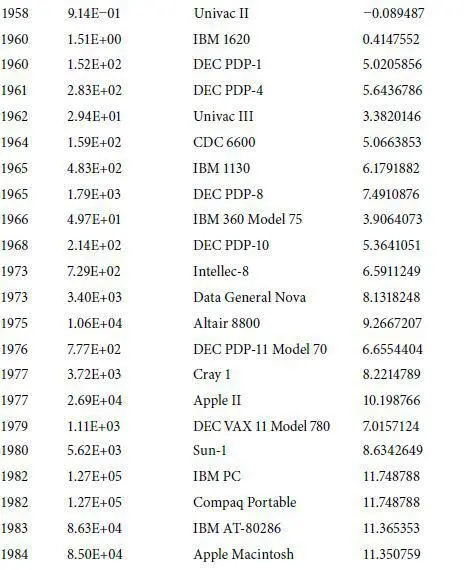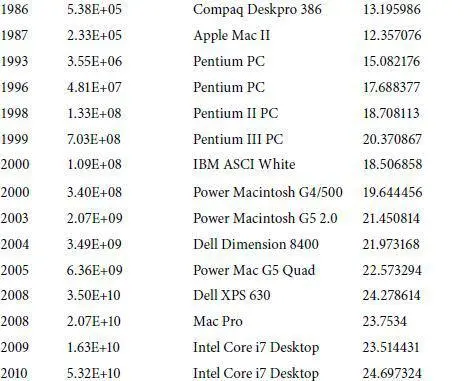11. S. McClelland III and R. E. Maxwell, “Hemispherectomy for Intractable Epilepsy in Adults: The First Reported Series,” Annals of Neurology 61, no. 4 (April 2007): 372–76.
12. Lars Muckli, Marcus J. Naumerd, and Wolf Singer, “Bilateral Visual Field Maps in a Patient with Only One Hemisphere,” Proceedings of the National Academy of Sciences 106, no. 31 (August 4, 2009), http://dx.doi.org/10.1073/pnas.0809688106.
13. Marvin Minsky, The Society of Mind (New York: Simon and Schuster, 1988).
14. F. Fay Evans-Martin, The Nervous System (New York: Chelsea House, 2005), http://www.scribd.com/doc/5012597/The-Nervous-System.
15. Benjamin Libet, Mind Time: The Temporal Factor in Consciousness (Cambridge, MA: Harvard University Press, 2005).
16. Daniel C. Dennett, Freedom Evolves (New York: Viking, 2003).
17. Michael S. Gazzaniga, Who’s in Charge? Free Will and the Science of the Brain (New York: Ecco/HarperCollins, 2011).
18. David Hume, An Enquiry Concerning Human Understanding (1765), 2nd ed., edited by Eric Steinberg (Indianapolis: Hackett, 1993).
19. Arthur Schopenhauer, The Wisdom of Life .
20. Arthur Schopenhauer, On the Freedom of the Will (1839).
21. From Raymond Smullyan, 5000 B.C. and Other Philosophical Fantasies (New York: St. Martin’s Press, 1983).
22. For an insightful and entertaining examination of similar issues of identity and consciousness, see Martine Rothblatt, “The Terasem Mind Uploading Experiment,” International Journal of Machine Consciousness 4, no. 1 (2012): 141–58. In this paper, Rothblatt examines the issue of identity with regard to software that emulates a person based on “a database of video interviews and associated information about a predecessor person.” In this proposed future experiment, the software is successfully emulating the person it is based on.
23. “How Do You Persist When Your Molecules Don’t?” Science and Consciousness Review 1, no. 1 (June 2004), http://www.sci-con.org/articles/20040601.xhtml.
Chapter 10: The Law of Accelerating Returns Applied to the Brain
1. “DNA Sequencing Costs,” National Human Genome Research Institute, NIH, http://www.genome.gov/sequencingcosts/.
2. “Genetic Sequence Data Bank, Distribution Release Notes,” December 15, 2009, National Center for Biotechnology Information, National Library of Medicine, ftp://ftp.ncbi.nih.gov/genbank/gbrel.txt.
3. “DNA Sequencing—The History of DNA Sequencing,” January 2, 2012, http://www.dnasequencing.org/history-of-dna.
4. “Cooper’s Law,” ArrayComm, http://www.arraycomm.com/technology/coopers-law.
5. “The Zettabyte Era,” Cisco, http://www.cisco.com/en/US/solutions/collateral/ns341/ns525/ns537/ns705/ns827/VNI_Hyperconnectivity_WP.xhtml, and “Number of Internet Hosts,” Internet Systems Consortium, http://www.isc.org/solutions/survey/history.
6. TeleGeography © PriMetrica, Inc., 2012.
7. Dave Kristula, “The History of the Internet” (March 1997, update August 2001), http://www.davesite.com/webstation/net-history.shtml; Robert Zakon, “Hobbes’ Internet Timeline v8.0,” http://www.zakon.org/robert/internet/timeline; Quest Communications, 8-K for 9/13/1998 EX-99.1; Converge! Network Digest , December 5, 2002, http://www.convergedigest.com/Daily/daily.asp?vn=v9n229&fecha=December%2005,%202002; Jim Duffy, “AT&T Plans Backbone Upgrade to 40G,” Computerworld , June 7, 2006, http://www.computerworld.com/action/article.do?command=viewArticleBasic&articleId=9001032; “40G: The Fastest Connection You Can Get?” InternetNews.com, November 2, 2007, http://www.internetnews.com/infra/article.php/3708936; “Verizon First Global Service Provider to Deploy 100G on U.S. Long-Haul Network,” news release, Verizon, http://newscenter.verizon.com/press-releases/verizon/2011/verizon-first-global-service.xhtml.
8. Facebook, “Key Facts,” http://newsroom.fb.com/content/default.aspx?NewsAreaId=22.
9. http://www.kurzweilai.net/how-my-predictions-are-faring.
10. Calculations per Second per $1,000



11. Top 500 Supercomputer Sites, http://top500.org/.
12. “Microprocessor Quick Reference Guide,” Intel Research, http://www.intel.com/pressroom/kits/quickreffam.htm.
13. 1971–2000: VLSI Research Inc.
2001–2006: The International Technology Roadmap for Semiconductors , 2002 Update and 2004 Update, Table 7a, “Cost—Near-term Years,” “DRAM cost/bit at (packaged microcents) at production.”
2007–2008: The International Technology Roadmap for Semiconductors , 2007, Tables 7a and 7b, “Cost—Near-term Years,” “Cost—Long-term Years,” http://www.itrs.net/Links/2007ITRS/ExecSum2007.pdf.
2009–2022: The International Technology Roadmap for Semiconductors , 2009, Tables 7a and 7b, “Cost—Near-term Years,” “Cost—Long-term Years,” http://www.itrs.net/Links/2009ITRS/Home2009.htm.
14. To make all dollar values comparable, computer prices for all years were converted to their year 2000 dollar equivalent using the Federal Reserve Board’s CPI data at http://minneapolisfed.org/research/data/us/calc/. For example, $1 million in 1960 is equivalent to $5.8 million in 2000, and $1 million in 2004 is equivalent to $0.91 million in 2000.
1949: http://www.cl.cam.ac.uk/UoCCL/misc/EDSAC99/statistics.xhtml, http://www.davros.org/misc/chronology.xhtml.
1951: Richard E. Matick, Computer Storage Systems and Technology (New York: John Wiley & Sons, 1977); http://inventors.about.com/library/weekly/aa062398.htm.
1955: Matick, Computer Storage Systems and Technology; OECD, 1968, http://members.iinet.net.au/~dgreen/timeline.xhtml.
1960: ftp://rtfm.mit.edu/pub/usenet/alt.sys.pdp8/PDP-8_Frequently_Asked_Questions_%28posted_every_other_month%29; http://www.dbit.com/~greeng3/pdp1/pdp1.xhtml#INTRODUCTION.
1962: ftp://rtfm.mit.edu/pub/usenet/alt.sys.pdp8/PDP-8_Frequently_Asked_Questions_%28posted_every_other_month%29.
1964: Matick, Computer Storage Systems and Technology; http://www.research.microsoft.com/users/gbell/craytalk; http://www.ddj.com/documents/s=1493/ddj 0005hc/.
1965: Matick, Computer Storage Systems and Technology; http://www.fourmilab.ch/documents/univac/config1108.xhtml; http://www.frobenius.com/univac.htm.
1968: Data General.
1969, 1970: http://www.eetimes.com/special/special_issues/millennium/mile stones/whittier.xhtml.
1974: Scientific Electronic Biological Computer Consulting (SCELBI).
1975–1996: Byte magazine advertisements.
1997–2000: PC Computing magazine advertisements.
2001: www.pricewatch.com (http://www.jc-news.com/parse.cgi?news/pricewatch/raw/pw-010702).
2002: www.pricewatch.com (http://www.jc-news.com/parse.cgi?news/price watch/raw/pw-020624).
2003: http://sharkyextreme.com/guides/WMPG/article.php/10706_2227191_2.
2004: http://www.pricewatch.com (11/17/04).
2008: http://www.pricewatch.com (10/02/08) ($16.61).
15. Dataquest/Intel and Pathfinder Research:
| Year |
$ |
Log ($) |
| 1968 |
1.00000000 |
0 |
| 1969 |
0.85000000 |
−0.16252 |
| 1970 |
0.60000000 |
−0.51083 |
| 1971 |
0.30000000 |
−1.20397 |
| 1972 |
0.15000000 |
−1.89712 |
| 1973 |
0.10000000 |
−2.30259 |
| 1974 |
0.07000000 |
−2.65926 |
| 1975 |
0.02800000 |
−3.57555 |
| 1976 |
0.01500000 |
−4.19971 |
| 1977 |
0.00800000 |
−4.82831 |
| 1978 |
0.00500000 |
−5.29832 |
| 1979 |
0.00200000 |
−6.21461 |
| 1980 |
0.00130000 |
−6.64539 |
| 1981 |
0.00082000 |
−7.10621 |
| 1982 |
0.00040000 |
−7.82405 |
| 1983 |
0.00032000 |
−8.04719 |
| 1984 |
0.00032000 |
−8.04719 |
| 1985 |
0.00015000 |
−8.80488 |
| 1986 |
0.00009000 |
−9.31570 |
| 1987 |
0.00008100 |
−9.42106 |
| 1988 |
0.00006000 |
−9.72117 |
| 1989 |
0.00003500 |
−10.2602 |
| 1990 |
0.00002000 |
−10.8198 |
| 1991 |
0.00001700 |
−10.9823 |
| 1992 |
0.00001000 |
−11.5129 |
| 1993 |
0.00000900 |
−11.6183 |
| 1994 |
0.00000800 |
−11.7361 |
| 1995 |
0.00000700 |
−11.8696 |
| 1996 |
0.00000500 |
−12.2061 |
| 1997 |
0.00000300 |
−12.7169 |
| 1998 |
0.00000140 |
−13.4790 |
| 1999 |
0.00000095 |
−13.8668 |
| 2000 |
0.00000080 |
−14.0387 |
| 2001 |
0.00000035 |
−14.8653 |
| 2002 |
0.00000026 |
−15.1626 |
| 2003 |
0.00000017 |
−15.5875 |
| 2004 |
0.00000012 |
−15.9358 |
| 2005 |
0.000000081 |
−16.3288 |
| 2006 |
0.000000063 |
−16.5801 |
| 2007 |
0.000000024 |
−17.5452 |
| 2008 |
0.000000016 |
−17.9507 |
16. Steve Cullen, In-Stat, September 2008, www.instat.com.
Читать дальше















